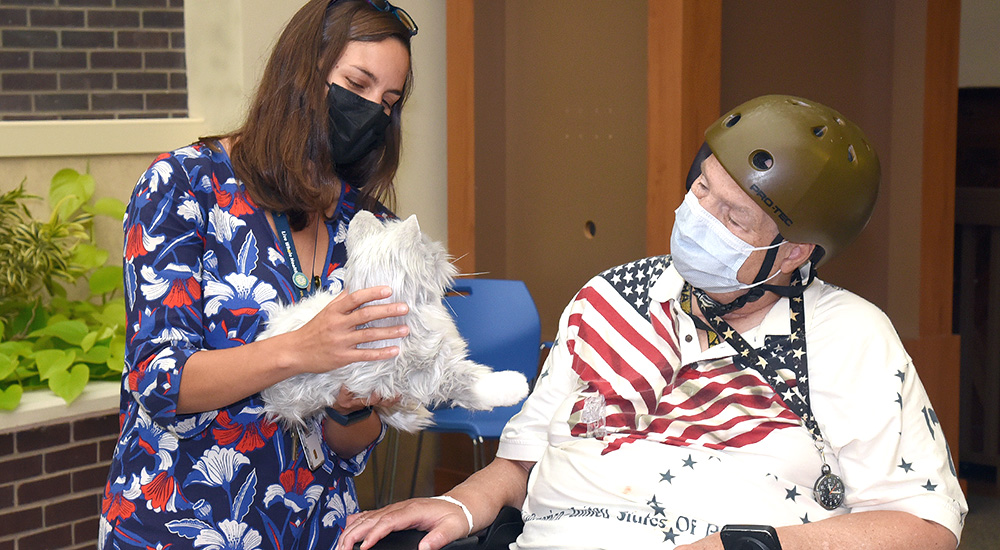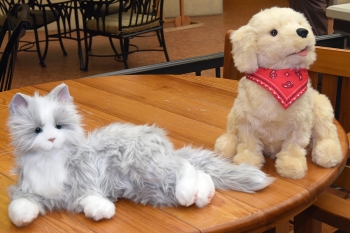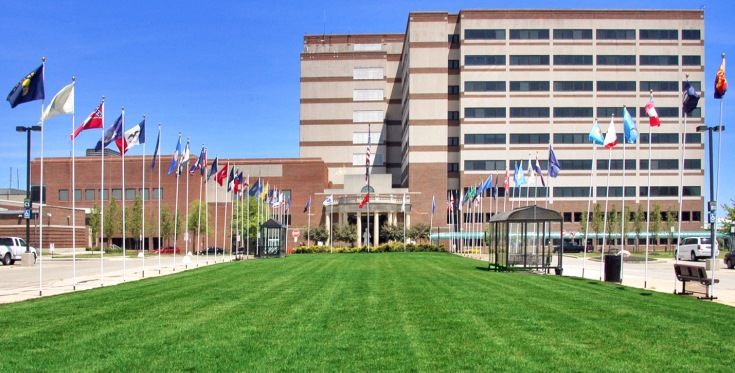Staff from Salisbury VA’s Community Living Center (CLC), which houses the facility’s long-term residents, recently distributed 12 robotic dogs and cats to be shared among CLC and hospice Veterans. Studies show these animals can be beneficial for a range of older adults.
The Whole Health team partnered with staff from Geriatrics and Extended Care (GEC) to address health and wellness among the residents.
“These are different from toys or traditional stuffed animals,” said Dr. Christina Vair, psychologist and Whole Health director. “They are designed to simulate a pet. They blink, move their eyes and make pleasant noises. And they can be especially helpful to patients with dementia, but also can benefit individuals without cognitive issues.”
Named robotic pet after a beloved pet of years ago
Marine Corps Veteran Richard Hodgin, who was a bit unsure at first about the robotic animals, eventually asked if he could have one. He promptly named it after a beloved pet he’d had many years ago, tucked it under his arm, and soon the Purple Heart recipient was sharing stories from when he was younger.
“We used to have dogs at the house, and they would drive the neighbors crazy,” he said. “At least I won’t have to worry about them running away.”
Salisbury VA director and Navy Veteran Joseph Vaughn watched as the Veterans interacted with the robotic pets and told stories of his own animals and how they make him feel.
“I have pets, and I know the love and joy they bring to one’s life,” Vaughn said. “I am excited that the CLC residents have the opportunity to receive these pets and hopefully it will bring a smile to their faces.”
Pets can bring back vivid memories of childhood
Vair said one of the main benefits to having robotic pets is reminiscence therapy.
“It engages them in reminiscing,” Vair said. “Some of our patients may not remember what happened to them yesterday but they have vivid memories about their childhood. Robotic pets serve as a prompt for patients and staff to engage on a more personal level. It opens the door to more conversations as they reflect on happy memories or life experiences.”
Vair believes these pets have great potential, especially given the additional isolation that COVID-19 has created for our Veterans.
“Regarding social isolation, a number of studies show that giving people in a nursing home something to take care of improves their mood,” Vair added. “Being able to care for something or show affection has been demonstrated to increase quality of life.”
The pets already have been effective in reducing a resident’s worry when distressed. One resident took the pet to a medical appointment for comfort. Whole Health continues to work to improve the lives of CLC Veterans by purchasing additional items, such as raised garden beds, sound machines, sensory aids and an indoor golf simulator.
“We’re going to continue to do all we can to enhance the lives of our long-term residents,” Vaughn added. “Sometimes seemingly minor changes make the biggest difference.”
Topics in this story
More Stories
The Dayton VA Medical Center released its March 2025 Good News Report, spotlighting compassionate care, special recognitions, and life moments shared by Veterans and staff.
Each year, I return to honor my old corpsman's memory and reflect on serving together.
Veteran was trained to collaborate with fellow Airmen. Having his buddy’s six was important, and still is.







Mr Hodgin is my brother. I noticed on the first day how he was enjoying his new pet. He was so excited he got one. Then he proceeded to show me all it’s tricks. He even said it was the best gift he has ever received. During the pandemic we haven’t been able to have our weekly lunch time visits. Our zoom visits are much appreciated, but he seems to tire and doesn’t have much to talk about. But now he will tell us all about his day with Pywacit his new cat. So I believe it is the best pet ever and you don’t even have to empty the litter box.